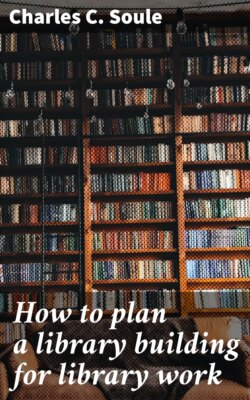Читать книгу How to plan a library building for library work - Charles C. Soule - Страница 9
На сайте Литреса книга снята с продажи.
Modern History
ОглавлениеTable of Contents
From the beginning of the seventeenth to the middle of the nineteenth century, there is little to chronicle in the evolution of the library building. What libraries were built or altered followed either the monastic-collegiate alcove style, or the Escorial-Trinity wall shelving and gallery, or both. The best illustrations of libraries of this era are still extant at Oxford and Cambridge. A view of what he calls the oldest example of the combination of high wall shelving broken by a gallery, with the older fashion of alcoves, as they still exist at the Bodleian Library at Oxford, is shown by Duff-Brown on p. 2. A fine specimen may be seen at Trinity College, Dublin, interesting because of two modern attempts to burst the confines of old walls: first, as shown in the traces of sliding cases long antedating those of the British Museum; second, in the two-story wooden stack recently installed and already outgrown, in the cloisters below the library, which were originally open but were glassed in to protect the stack. (See illustrations, reproducing photographs taken by the author.[5])
The first appearance of the floor case, the precedent of the modern stack, appears in the library of the University of Leyden in 1610, of which a large illustration is given by Clark[6] and a smaller one by Fletcher.[7] Here is seen the utilization of the whole floor of a book room through parallel cases evidently open to access, although the books are all chained. The library is lofty and the shelves lighted not directly from stack-windows, but by chapel windows high in the wall, which appear to fill the room with ample diffused light. Some of the “broad-brims” pacing the floor may have been our Pilgrim ancestors, who, for the ten years subsequent to the date of this picture, were living at Leyden and frequenting the University.
The Radcliffe Library at Oxford, designed in 1740, seems to be the earliest example in England of a circular reading room lighted from the roof. This is said to have been suggested by the central reading room of the old Wolfenbüttel Library, built about 1710.
“The first architect,” says Duff-Brown[8] “to plan a library which in any way meets the modern requirements of giving ample accommodation was Leopoldo della Santa, who in 1816 published in Florence a quarto pamphlet, which is an attempt to construct a library building entirely from an utilitarian point of view.” The plan, which Brown reproduces, suggests Dr. Poole’s plan which was embodied in the Newberry Library of Chicago.
In 1835 Delassert proposed for the French National Library a circular plan of building, which perhaps suggested the present reading room of the British Museum. In 1885 Magnusson proposed an unending whorl as a good form for a growing library.[9]
While English libraries, and those of the continent, were developing these phases of old types, separate library buildings began to appear in America. The first one actually erected for library occupation still remains in use,—the Redwood Library of Newport, R. I., built in 1750. The main room is a hall 37 × 26 feet, 19 feet high, with two lean-to rooms at the sides. A massive portico gives an impressive front, but cannot be said to found a distinctive library style.
Our early proprietary associations and parochial libraries were stored in public buildings, or in buildings with no peculiar features. The school district libraries established by the state of New York in 1835, and similar libraries founded soon after in other states, seem to have been stored in schoolhouses, though intended for public use. The state libraries, first established as early as 1773, were deposited in the State Houses. The Young Men’s libraries of the early period were kept in rented rooms, or at best in rented houses. No special phase of library buildings was developed until about the middle of the nineteenth century, when colleges began to build. Gore Hall at Harvard (1841) was modeled after King’s College Chapel at Cambridge, Eng., and was even at that date said to be “ill adapted to the purposes of a library.” The University of North Carolina “erected” in 1850 a library in the form of a Greek temple, with hall 84 × 32 feet, 20 feet high. These essays at importing styles certainly developed no models worth imitation, but nevertheless they were imitated.
